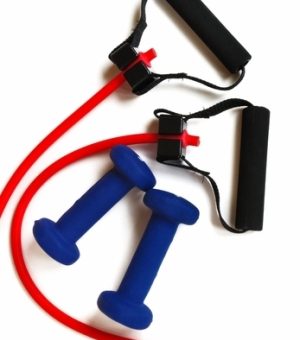Bone Density & Weight Training
Our modern society has experienced a rising awareness of overall health and fitness and healthcare providers are focusing on the importance of preventing medical issues through lifestyle changes. One of the hallmark features of aging is loss of bone strength and muscle mass, which can potentially lead to decreased functional ability and an increased risk of injury. Today’s aging population is faced with an increase of spine, hip, shoulder, and wrist fractures due to weakened bones, or osteoporosis. Current studies show that 1 in 2 women and 1 in 4 men over the age of 50 will sustain an osteoporotic fracture.1 The cost of osteoporosis to Americans is increasing; according to the National Osteoporosis Foundation of America, more than 38 million dollars are spent daily on osteoporotic and associated fractures. Osteoporosis is not considered a normal aspect of aging, as it is highly preventable and early treatment can greatly reduce the risks of chronic skeletal issues.
It is important to understand that osteoporosis is not a disease in the clinical sense, but a condition. Osteoporosis is a multi-faceted ailment caused by numerous interrelated factors and it must be treated as such for optimal prevention and treatment.Until about age 30-35, our bones are in a constant state of building. After that time, we begin to lose bone density. Bone strength can be affected by heredity, diet, sex hormones, physical activity, lifestyle choices, and the use of certain medications.1 For the prevention and management of osteoporosis, it is necessary to use an interactive approach that integrates lifestyle interventions in order to maintain bone health. Bone is a living tissue, constantly undergoing demolition and renewal as it responds to changing forces in the environment. Like muscle, bone responds to exercise by becoming stronger. Lack of weight-bearing exercise is considered one of the earliest contributing risk factors to decreased bone density, as a sedentary lifestyle reduces the constant forces that bone needs in order to continue its normal process of remodeling.1 Exercise is vital at any age for improving bone health and preventing weakened bone density. A regular exercise program that includes resistance training will allow us to maintain bone and muscle strength, coordination, and balance, which will help prevent falls and related fractures.
Research has shown that resistance training and impact loading exercises can restore bone mineral density in men and women of all ages. In response to loading of the bone, created by repetitive muscular contractions or mechanical forces, the bone begins the process of remodeling.2 This important process involves the manufacturing of protein molecules that are deposited into the spaces between bone cells, creating a bony matrix that gives bone its rigid structure and strength. In order to create long-lasting improved bone health, there needs to be systematic administration of sufficient stimulus, followed by adaptation of the tissue, and then the introduction of a new, increasingly greater stimulus. Implementing a consistent and progressive resistance training program can greatly reduce the risk of developing osteoporosis or any bone demineralization.
Activities that stimulate bone growth need to include progressive overload, variation of load, and specificity of loading.2 Utilizing progressive overload allows the bone and associated connective tissue to develop necessary strength without being asked to exceed the critical level of safety. Specificity of loading refers to exercises that directly place a load on a certain region of the skeleton. With osteoporosis, the sites of fracture that are most devastating are in the axial skeleton (the spine and hip). Multi-joint motions (such as squats, lunges, and deadlifts) direct forces through the axial skeleton and allow greater loads to be utilized. Progressive and specific loading of the muscles, bones, and joints through safe and effective ranges of motion will improve bone health, bone strength, and total body functioning.
For any resistance training program, it is essential to use proper form and technique for each exercise. Utilizing proper body mechanics will ensure maximal bone strengthening benefit without compromising the tissues or putting the body at risk for injury. It is important for the individual to feel competent and safe while performing each exercise. Today, both sexes are embracing weight training, resistance training, and plyometric exercises. When performed with proper technique, weight lifting can not only help you lose weight and build lean mass but can also help you work towards a healthier and stronger future.

Melissa Treat, RN, BS, CPT
Tysons Sport & Health
References
- Humphries, B. D. (2009). Strength training for bone, muscle, and hormones. American College of Sports Medicine. Retrieved from acsm.org/docs/current-comments/strengthtrainingforbmh.pdf
- Kravitz, L. (2006). Resistance training: Adaptations and health implications. IDEA Today, 14(9), 38-46.



